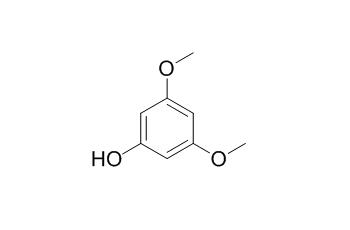3,5-Dimethoxyphenol
3,5-Dimethoxyphenol, a cyanogenic aglylactone considered as a marker of Taxus poisoning, being present in all species of Taxus. It has potent tyrosinase-inhibiting activity.
Inquire / Order:
manager@chemfaces.com
Technical Inquiries:
service@chemfaces.com
Tel:
+86-27-84237783
Fax:
+86-27-84254680
Address:
1 Building, No. 83, CheCheng Rd., Wuhan Economic and Technological Development Zone, Wuhan, Hubei 430056, PRC
Providing storage is as stated on the product vial and the vial is kept tightly sealed, the product can be stored for up to
24 months(2-8C).
Wherever possible, you should prepare and use solutions on the same day. However, if you need to make up stock solutions in advance, we recommend that you store the solution as aliquots in tightly sealed vials at -20C. Generally, these will be useable for up to two weeks. Before use, and prior to opening the vial we recommend that you allow your product to equilibrate to room temperature for at least 1 hour.
Need more advice on solubility, usage and handling? Please email to: service@chemfaces.com
The packaging of the product may have turned upside down during transportation, resulting in the natural compounds adhering to the neck or cap of the vial. take the vial out of its packaging and gently shake to let the compounds fall to the bottom of the vial. for liquid products, centrifuge at 200-500 RPM to gather the liquid at the bottom of the vial. try to avoid loss or contamination during handling.
Pharmacol Res.2022, 182:106346.
Nutrients.2020, 12(12):3607.
Molecules.2019, 24(10):E1930
Korean J of Crop Science2019, 452-458
Front Pharmacol.2017, 8:205
Horticulture, Environment, and Biotechnology2025, 66:729-739.
Molecules.2023, 28(10):4062.
Environ Toxicol.2024, 39(4):2417-2428.
Current Enzyme Inhibition2023, 19(1):55-64(10)
Front Chem.2024, 12:1385844.
Related and Featured Products
Yakugaku Zasshi. 2006 Mar;126(3):173-7.
Synthesis and cosmetic whitening effect of glycosides derived from several phenylpropanoids.[Pubmed:
16508241]
Plant-derived phenylpropanoid compounds (4-ethyl-2-methoxyphenol, 2,6-dimethoxyphenol, 2,3-dimethoxyphenol, 3,4-dimethoxyphenol, 3,5-Dimethoxyphenol, 3,4-dihydroxycinnamic acid, 4-hydroxy-3-methoxycinnamic acid, and 3-hydroxy-4-methoxycinnamic acid) were glycosidated to form glycoside compounds.
METHODS AND RESULTS:
We evaluated the effects of these compounds on the inhibition of tyrosinase and melanin synthesis and their cytotoxicity from the viewpoint of their use as whitening agents in cosmetics.
CONCLUSIONS:
Some compounds had more potent tyrosinase-inhibiting activity than commercial arbutin, which was used as a control, and showed no cytotoxicity at low concentration ranges.
J Anal Toxicol. 2010 Jan-Feb;34(1):53-6.
Preliminary gas chromatography with mass spectrometry determination of 3,5-dimethoxyphenol in biological specimens as evidence of taxus poisoning.[Pubmed:
20109304]
Taxus baccata is a widely distributed yew often associated with cases of fatal intoxication, which is related to the high amounts of cardiotoxic alkaloids, taxine A and taxine B, contained in its leaves.
METHODS AND RESULTS:
In this paper, a case of Taxus fatal poisoning, hypothesized by the forensic autopsy, has been confirmed by the application of both gas chromatography-mass spectrometry (GC-MS) and liquid chromatography-tandem mass spectrometry (LC-MS-MS) techniques. A GC-MS method was used for the determination of the derivatized 3,5-Dimethoxyphenol, a cyanogenic aglylactone considered as a marker of Taxus poisoning, being present in all species of Taxus.
CONCLUSIONS:
The detection by LC-MS-MS of taxine B and isotaxine B in the biological specimens confirmed the absorption of cardiotoxic alkaloids and allowed to established the cause of death as the ingestion of Taxus baccata leaves.



